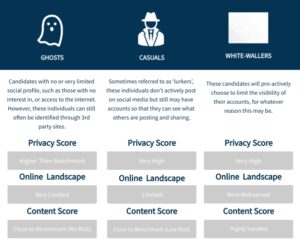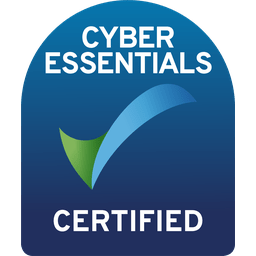Something to Hide? Or Sensible Management?
We are often asked by our clients what they should read into a candidate whose Social Media Check shows a high level of Online Privacy. Are they trying to hide something, perhaps using aliases, do they just want to be private and limit who they interact with, or is it simply sensible management? Perhaps they don’t even have access to social media. Lawfully, we report on information publicly available online which can be conclusively linked to the candidate’s personal details, but how can an employer assess risk?
It’s important to note that keeping an account private does not mean the check is diluted in its objectives. Postings made by others such as shares, likes and re-posts of the candidate’s posts, as well as pictures and videos posted on other’s accounts which include tags to the candidate can all still identify critical risks and are mostly out of the control of the candidate.
One of the key metrics shown on our reports is a candidate’s Privacy Score. The higher this number is, the more private their information is. To assess this, we look at two main factors, the overall Landscape, and the Type of Content shared.
Landscape and Content
A candidate’s online Landscape looks at the volume and breadth of information they share and the number of different sites and applications they use. It measures a vast range of online expressions including likes, shares, followers, followings, tweets, re-tweets, videos and pictures posted by the individual, size of network, links to groups and more besides.
The Type of Content looks at the nature of what they post and share, such as the degree of personal information which is publicly available from their accounts and expressed in various media formats and website functions. This includes pictures and videos, personal likes and shares, published details about family and close friends through posts, tags, location stamps, and much more.
When these two are combined, it enables us to build up a full picture of the candidate that we can then benchmark against our database.
Categories
We have identified three broad categories of individual that typically have a high or very high Privacy Score:
- Ghosts
- Casuals
- White-Wallers
These three categories are explained in more detail below:

Case Studies
Case Study 1
A candidate had applied for a role as a fire officer at a UK Airport. Our systems and human researchers identified additional online usernames and other details being used by the candidate. Their more common social media accounts were kept private — Facebook was white-walled and tweets set to private mode, and so not much being revealed. However, the candidate had been liking and sharing YouTube videos under one of their alternate usernames which we could conclusively link to their Facebook account. The videos were actively promoting support of ISIS and being used by this Proscribed Organisation for marketing and recruitment.
Conclusion: Despite being a White Waller, we were able to highlight the risks through other social media functions such as likes and shares and through the user’s alternative online credentials, helping the recruiter to assess the associated risk with appointing the candidate into an airside role.
Case Study 2
A banking client requested a check for a candidate being appointed into a role as Senior Private Banker. The candidate was classified as a ‘Casual’ online user from our initial evaluation, meaning that their numerous online accounts were kept private with little visible. However, on a friend’s Facebook account the candidate had been tagged in multiple videos featuring himself, together with derogatory posts referring to the individual’s behaviour. On further research the candidate was clearly seen to be acting in a grotesque manner and would potentially cause harm to the employer’s business and reputation. The videos had the potential to go viral. The employer engaged with the candidate to have the content removed, but due to the fact it was on another person’s account, this proved impossible for the candidate.
Conclusion: Despite keeping accounts private, the candidate was exposed by their network links and our team was able to provide the associated risk analysis in the candidate’s Premium Report.
Overview
In the context of a Social Media Check, ‘hidden’ information does not in itself present a risk to the employer, since the subject matter of the Check is ‘what is presented online’. The technology and expertise used during a Social Media Check process goes well beyond looking at the ’white wall’ of a single account and is likely to unveil hidden gems of intelligence which are especially relevant and hidden to the untrained eye. Our professional and innovative Social Media Checks support you through:
Consistency, Compliance, Fairness and Objectivity
Being prepared by using online intelligence to screen candidates ensures current and relevant checks are carried out and risks are identified at the earliest possibility. Claiming you didn’t know about a person’s character, potentially risky network connections or adverse media is no longer acceptable if it is openly shared online.


